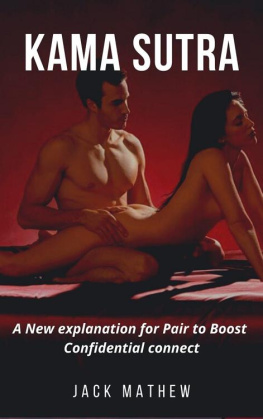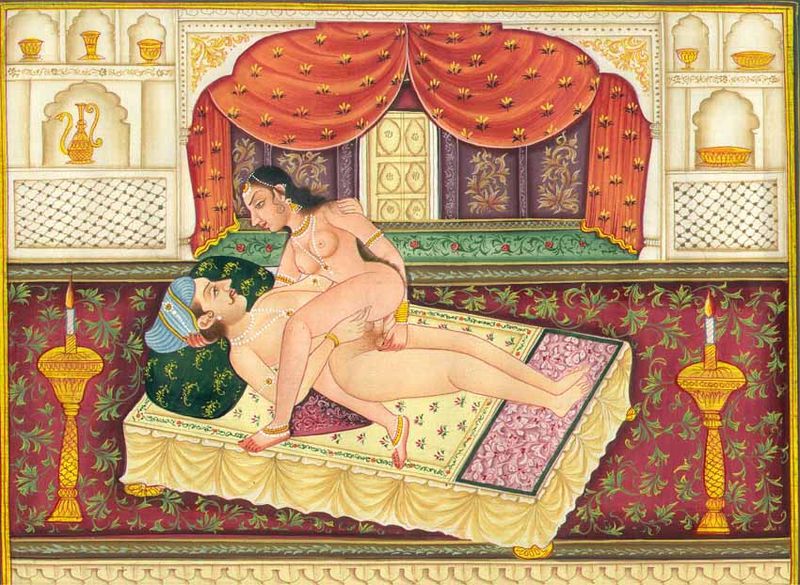KAMA SUTRA
A Guide To Reach The Nirvana Of Pleasure. Spice Up Your Sex Life With Over 101 Illustrated Sex Positions, Boost Intimacy & Drive Your Partner Wild
ZOE LOXLEY
Copyright 2020 by Zoe Loxley - All rights reserved.
This document is geared towards providing exact and reliable information with regards to the topic and issue covered. The publication is sold with the idea that the publisher is not required to render accounting, officially permitted, or otherwise, qualified services. If advice is necessary, legal or professional, a practiced individual in the profession should be ordered.
From a Declaration of Principles which was accepted and approved equally by a Committee of the American Bar Association and a Committee of Publishers and Associations. In no way is it legal to reproduce, duplicate, or transmit any part of this document in either electronic means or in printed format. Recording of this publication is strictly prohibited and any storage of this document is not allowed unless with written permission from the publisher. All rights reserved.
The information provided herein is stated to be truthful and consistent, in that any liability, in terms of inattention or otherwise, by any usage or abuse of any policies, processes, or directions contained within is the solitary and utter responsibility of the recipient reader. Under no circumstances will any legal responsibility or blame be held against the publisher for any reparation, damages, or monetary loss due to the information herein, either directly or indirectly.
Respective authors own all copyrights not held by the publisher.
The information herein is offered for informational purposes solely and is universal as so. The presentation of the information is without contract or any type of guarantee assurance. The trademarks that are used are without any consent, and the publication of the trademark is without permission or backing by the trademark owner. All trademarks and brands within this book are for clarifying purposes only and are owned by the owners themselves, not affiliated with this document.
Table of Contents
CHAPTER 1: GENERAL INTRODUCTION ON KAMASUTRA
"For lovers united in sexual ecstasy, it is passion that makes things happen [...] In the battle of sex lovers, blinded by passion and overwhelmed by impetuous energy, pay no attention to the dangers [...] ".
T his quote is taken from chapter 12 of the Kamasutra, the ancient book of Indian origin that gives guidance on eros, love and sexuality. Inside it are, in fact, illustrated the best positions to hold during sex in order to reach the "kama", which in Sanskrit means pleasure or ecstasy. Let's try to understand more about this book, its inventor and its meaning.
The Kamasutra is an ancient Indian text that studies human sexual behavior. It is considered a very important work in Sanskrit literature which has as its subject love, desire, ecstasy, excitement and sensuousness, as well as sexuality in the strict sense.
The Kamasutra was written around the second century by Vatsyayana and the real title of the book is Vatsyayana Kama Sutra, or "Aphorisms about the love of Vatsyayana". It is composed of 7 books that aim to explain how to achieve human harmony. According to the author, there are four goals that every man must have in life: well-being, pleasure, ethical sense and liberation from the material world.
Of course, the most famous part is the one about pleasure, which, according to the author, can be achieved in 64 different ways, called the arts. In particular, there are eight different ways of making love, which are divided into eight positions for a total of 64. Each position is illustrated through images and is normally defined with the name of an animal.
The part of the book dedicated to sexual positions, begins by addressing the topic of kissing, and then deepens on topics such as foreplay, orgasm, oral sex and even threesomes. In Indian culture, in fact, sex is a form of divine union that has nothing to do with the idea of a sinful act that has spread in the Western world.
The complete work therefore deals with moral issues, it deals with courtship and relationships between men and women. In particular, the first book deals with the relationship between man and woman; the second focuses on kissing, foreplay, sex; the third is based on courtship; the fourth on the behavior that a wife must have; the fifth summarizes the art of seduction; the sixth deals with the subject of courtesans, while the seventh chapter explains how to revive a passion that has now died out.
History of Kamasutra
The "Kama Sutra" (sometimes presented as one letter, "Kamasutra") is thought to be composed by a religious student and philosopher called Vatsyayana in around ADE 320 to 550 India (during the Gupta Golden Age). The title is loosely translated as "The Aphorism of Love," or "Formula of Lust," depending on who you ask.
The date or century of original composition for the Kamasutra is uncertain. Historians placed it in various places between 400 BCE and 300 CE. The Kama Sutra is a compendium compiled in its current form during the 2nd century CE, according to John Keay. By comparison, the indologist Wendy Doniger who co-translated Kama sutra and published several Hindu-related text documents, the living version of the Kamasutra must have been reviewed or written after 225 CE since it mentions the Abhiras and Andhras dynasties which had not co-ruled major regions of ancient India before that year.
It's also uncertain the location of its composition. The probable candidates are urban centers of ancient India in the north or northwest, preferably in Pataliputra (now Patna) in the east.
Vatsyayana Mallanaga is its generally accepted author, since the colophon verse embeds his name, but little is known about him. After much meditation, Vatsyayana notes that he wrote the letter. Vatsyayana states in the preface that he is distilling several ancient texts, but these have not survived. He cites the work of those he calls "teachers" and "scholars," including Auddalaki, Babhravya, Dattaka, Suvarnanabha, Ghotakamukha, Gonardiya, Gonikaputra, Charayana, and Kuchumara 's longer texts. This cites Vatsyayana's Kamasutra and several verses quoted in Varahamihira's Brihatsamhita, as well as Kalidasa's poems. This indicates that he lived ahead of CE in the 5th century.
According to legend, the opera was even of divine origin. The Indian god Shiva, in fact, fell in love with the female projection of his figure and after having enjoyed the pleasures of sexual intercourse with it, he decided to hand down the discoveries he had made dictating them to his servant Nadir. Attraction is considered a natural impulse that should never be repressed but, on the contrary, must be indulged. Consequently, the origin of the work would refer precisely to the direct experiences of the divinity, which is why there is no reason to be ashamed to put such advice into practice.
The 4 Key Principles Of Kamasutra
In Hindu temples kama-related arts are growing. These scenes include courtship, intimate (mithuna) scenes, amorous couples, or a sexual position. Above: the temples of Madhya Pradesh, Uttar Pradesh, Rajasthan, Gujarat, Karnataka, Chhattisgarh, Odisha, Tamil Nadu, Andhra Pradesh and Nepal from the 6th to 14th centuries.











